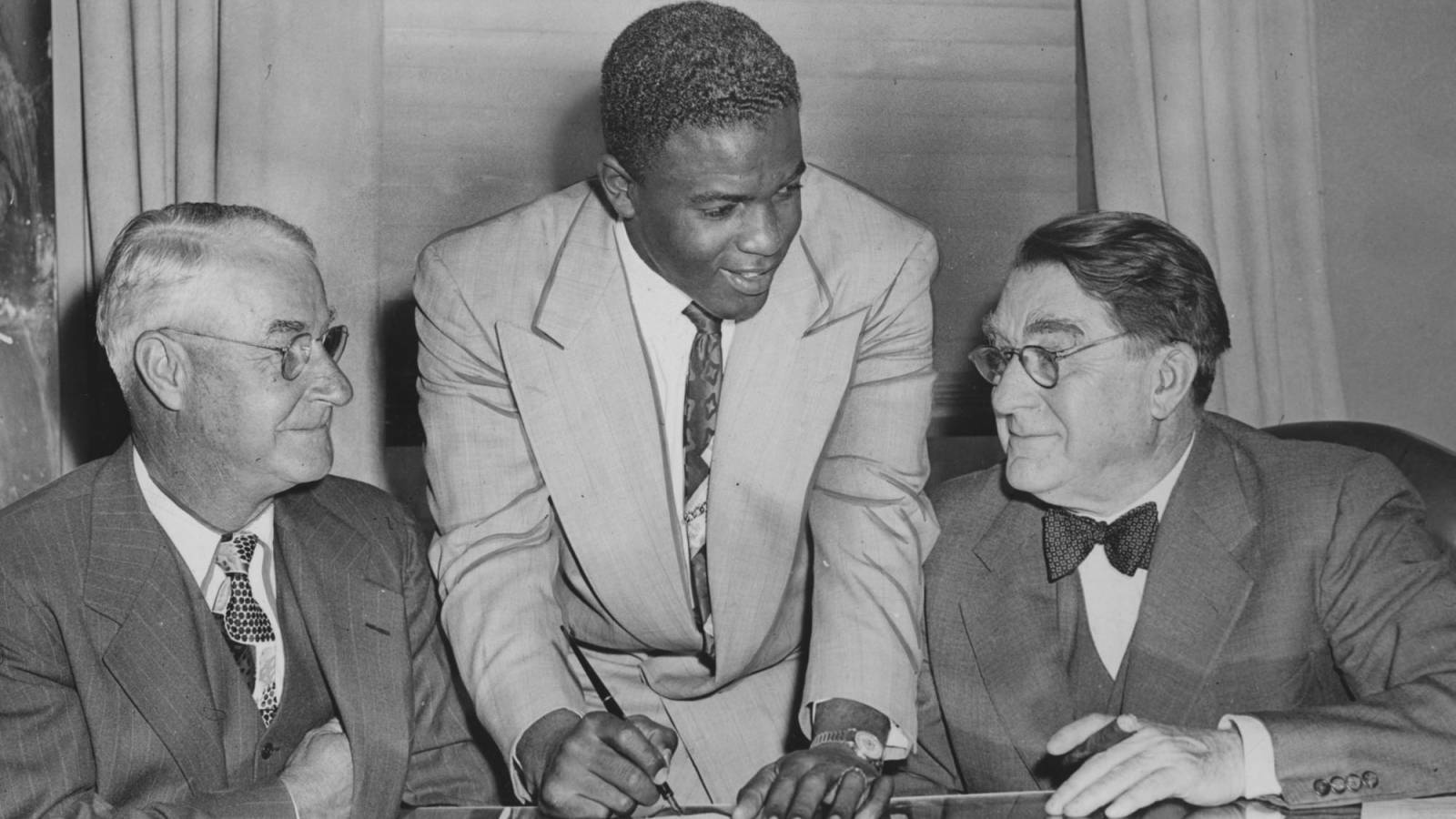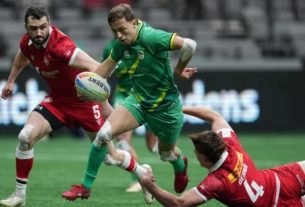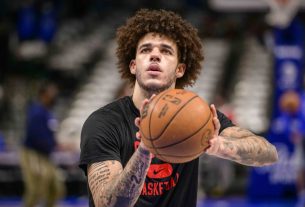The plight of the African-American experience in America has been tightly intertwined with and displayed through the lens of the national pastime. Whether it be the fight to break through the ranks or continuing to raise the profile of both heroes and the game itself, it is impossible to tell the tale of Major League Baseball without including the story of its exclusion of African-Americans along the way.
Black History Month is upon us, and with spring training primed to get started later in the month, it is the perfect time to take a look back at the rich history of the intersection of the sport and the culture. The story of blacks in baseball is a triumphant one that remains relevant and unforgettable to this day.
1 of 31
Moses ‘Fleetwood’ Walker: The first black player in baseball history
Transcendental Graphics/Getty Images
Jackie Robinson broke MLB’s color barrier in 1947, but Moses “Fleetwood” Walker, who played for the Toledo Blue Stockings of the American Association, was the first African-American professional baseball player. In fact, Walker and his brother, Weldy, were the impetus for the color line to be drawn in 1884, which Robinson then broke in ’47.
2 of 31
1947: Jackie Robinson breaks the color barrier

Afro Newspaper/Gado/Getty Images
The most egregious case of collusion in the history of sports was Major League Baseball’s “gentlemen’s agreement” among owners to exclude players of African descent from the game. Although some lighter-skinned Hispanic and Pacific Islander players could pass into the game during the early 1900s, the hard-line drawn against African-Americans stood firm and was staunchly upheld by commissioner Kenesaw Mountain Landis throughout his 23-year reign over the game. In the second year of his successor, Happy Chandler’s, tenure though, the Brooklyn Dodgers signed Negro Leaguer and former UCLA star Jackie Robinson to a contract. The following spring, on April 15, Robinson made an indelible mark in history when he suited up in an MLB game and changed the course of everything that would follow.
3 of 31
1947: Larry Doby integrates the American League
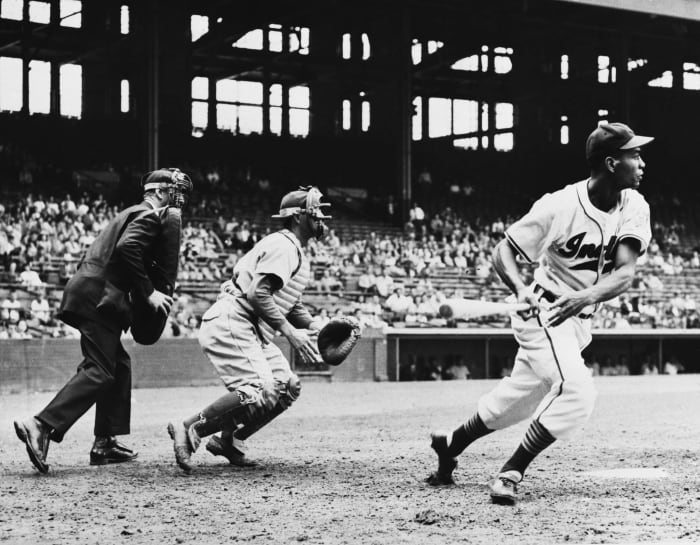
Bettmann/Getty Images
Robinson was not on his own for long. The Cleveland Indians followed suit by becoming the first AL team to integrate its ranks when they signed outfielder Larry Doby. The Indians were owned by Bill Veeck, who pushed for integration as early as 1942 but was blocked by Landis. On July 3, Veeck purchased Doby’s rights from the Newark Eagles of the Negro National League, and two days later he made his MLB debut. Doby would go on to become the first African-American player to lead a league in home runs when he connected for 32 in 1952, in addition to becoming a seven-time All-Star.
4 of 31
1948: Satchel finally makes his way to the majors

Bettmann/Getty Images
Leroy “Satchel” Paige was the greatest pitcher the Negro Leagues ever saw and is regarded as perhaps the greatest pitcher of all time, regardless of league. The stories of his feats on the mound are legendary, but due to the color barrier, Paige’s best form never graced an MLB mound. However, the ageless wonder did finally get the chance to suit up in the majors in 1948 when he had his “rookie” year for the Cleveland Indians — at 41 years old. Over six seasons spent mostly as a reliever, he converted 33 saves and held a 3.29 ERA before playing his final game at age 58 in 1965.
5 of 31
1949: First black pitcher and batter face off

Bettmann/Getty Images
1949 became the first time that a black pitcher faced a black batter in a major league game. Don Newcombe of the Brooklyn Dodgers faced off against Hank Thompson of the New York Giants on July 8. Thompson hit leadoff for the Giants, and Newcombe recorded the out by inducing a pop-up to third base.
6 of 31
1951: Monte Irvin’s star carries over

Bettmann/Getty Images
Irvin was one of the final stars of the final years of the Negro Leagues, and his star turn continued into the majors as well. Irvin finished third in MVP voting in 1951, leading the NL with 121 RBIs. He made his All-Star debut the following year before guiding the New York Giants to the 1954 World Series title alongside outfield mate and fellow Negro League alumnus Willie Mays.
7 of 31
1954: “The Catch”

Bettmann/Getty Images
Speaking of Mays and the 1954 World Series, Game 1 was host to one of the most — if not the most — iconic plays in baseball history. In the eighth inning with two runners on, on a dead sprint chasing a deep drive by the Indians’ Vic Wertz, Mays made a seemingly impossible grab with his back turned to the infield. In the process, he not only robbed Wertz of a hit that would have pulled Cleveland ahead, but he also unleashed a laser-fast throw back into the infield that froze the runners on base. It was an incredibly comprehensive display of the amazing athleticism that keeps Mays on the shortlist of greatest defenders of all time.
8 of 31
1955: Campanella wins his third MVP

The Stanley Weston Archive/Getty Images
A year after Jackie Robinson broke into the majors, a second future Hall of Famer joined him in Brooklyn. Roy Campanella was regarded as one of the finest catchers ever, as his three NL MVP Awards in the 1950s pay credit to. “Campy” picked up the honor in 1951 (making him the first black MVP winner), 1953, and 1955. He led the Dodgers to the 1955 World Series title and made eight straight All-Star appearances starting in 1949. He also became one of the first African-American athletes to appear in a national advertising campaign, which he did for Gillette shaving razors.
9 of 31
1956: The first Cy Young winner

The Stanley Weston Archive/Getty Images
The Dodgers boasted many of the great African-American talents in the early days of integration, and their ace Don Newcombe stood head and shoulders above many pitchers of the time. In 1956, Newcombe won the inaugural Cy Young Award when he led baseball with 27 wins on the season. He had already become the first black pitcher to reach 20 victories in a year when he did so in 1951.
10 of 31
1959: MVP (times two) for Mr. Cub

Bettmann/Getty Images
While his sunny disposition amid some perennially tough times has become legendary, Ernie Banks was better known in his time for his potent bat. After winning the 1958 NL MVP, Banks followed up with an encore MVP season a year later. In the process, he became the first black player to win consecutive MVP honors. Over the course of the two-year run, the legendary shortstop totaled a .308 average, .605 slugging percentage, 92 home runs, and 272 RBI.
11 of 31
1959: Integration is finally complete
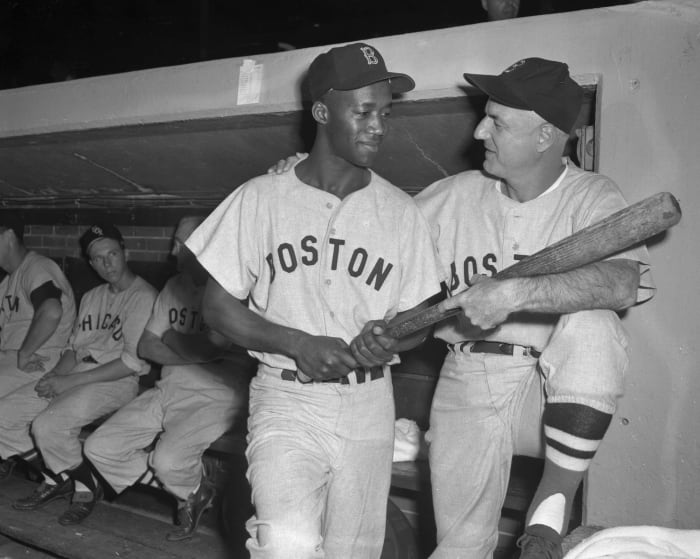
Bettmann/Getty Images
Unwilling to fall behind the increased talent of integrated rosters, many MLB teams quickly adopted African-American players throughout the 1950s. However, there were a handful of teams that were still slow to integrate. The Detroit Tigers became the final American League team to integrate when Ozzie Virgil Jr. joined the club in June 1958. When Pumpsie Green suited up for the Boston Red Sox in July 1959, every MLB team had finally boasted an African-American player from its ranks — over 12 years after Robinson’s debut.
12 of 31
1962: The first black player is the first black Hall of Famer

Icon Sportswire/Getty Images
While Robinson’s most noted career event was breaking the color barrier, his place in history was affirmed by far more than just being the first to have his name written on a lineup card. Robinson was named baseball’s first Rookie of the Year recipient and stolen base leader in 1947. He became the league’s first African-American MVP and batting champion in 1949. Along with Don Newcombe, Roy Campanella, and Larry Doby, he was among the first four black MLB All-Star selections in 1949 and the first black player to appear in a World Series, which he did in six of his 10 seasons. For all of this and more, Robinson appropriately became the first African-American to be enshrined in the National Baseball Hall of Fame in 1962.
13 of 31
1962: Buck becomes the first black coach
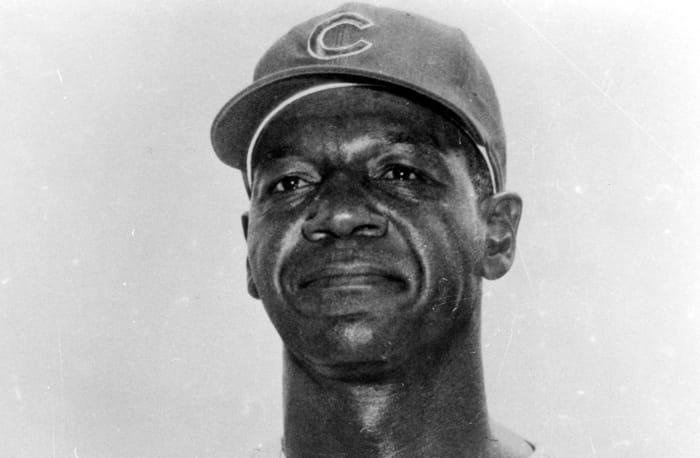
Transcendental Graphics/Getty Images
While he would go on to greater fame a few decades later when he provided a stunning oral history of Negro League baseball for Ken Burns‘ famous documentary on the sport, Buck O’Neil made a notable impact of his own on MLB as well. In 1962, he became the first African-American coach in the league’s history when he joined the staff of the Chicago Cubs.
14 of 31
1966: The first black umpire
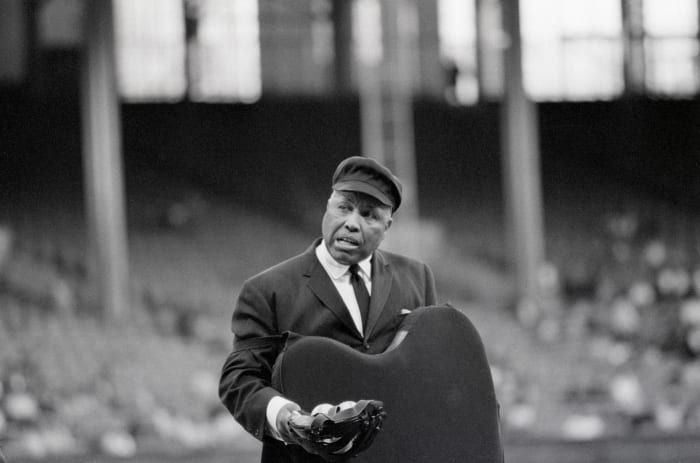
Bettmann/Getty Images
After a career that spanned several professional leagues along the way, including the Southwestern League when in 1951 he became the first African-American to umpire a predominantly white league, Emmett Ashford got the call to the big show. On April 12, 1966, Ashford became the first black MLB umpire and quickly became one of the most respected — and eccentric — umps of all time.
15 of 31
1966: The first (and only) black Triple Crown

Bettmann/Getty Images
Freshly jettisoned from Cincinnati, where he hit 324 home runs and was named 1961 MVP for the Reds, Frank Robinson put on a show in his first year with the Baltimore Orioles. His .316 batting average, 49 home runs, and 122 RBIs made him the first African-American hitter to complete the Triple Crown. His effort also helped push the Orioles to a World Series sweep over the Los Angeles Dodgers.
16 of 31
1968: Gibson dominates the summer of ’68

Focus On Sport/Getty Images
There are few seasons that compare to the one Bob Gibson had in 1968 for the St. Louis Cardinals. The intimidating hurler posted a 1.12 ERA en route to winning the National League MVP and Cy Young. It was the lowest ERA for a starting pitcher since Dutch Leonard’s 0.96 54 years earlier and remains by far the best mark of the “live ball” era, which began in 1920. Gibson also set a World Series record with 17 strikeouts in Game 1 against the Detroit Tigers the same year.
17 of 31
1969: Flood fights for freedom

Louis Requena/Getty Images
Although he was one of the most brilliant center fielders of his time, as his seven Gold Glove Awards attest, Curt Flood made his most enduring impact off the field. Along with labor lawyer Marvin Miller, Flood’s refusal to accept a trade following the 1969 season set into motion the repeal of the game’s reserve clause, which eventually ushered free agency and the 10/5 veteran trade restriction rule into play. While the outcome resulted in Flood being blackballed from the game after 1971, he changed the course of baseball in a major way.
18 of 31
1971: A black diamond in Pittsburgh

Bettmann/Getty Images
Just a few years after integration, the Dodgers got close to fielding a completely black team when in 1954 in a game against the Boston Braves, five of their starting nine were African-Americans. The Pirates rounded out the diamond in 1971. When Al Oliver, Rennie Stennett, Jackie Hernandez, Dave Cash, Manny Sanguillen, Gene Clines, Roberto Clemente, Willie Stargell, and Dock Ellis took the field together, it marked the first time that a major league lineup consisted entirely of players of African descent.
19 of 31
1971: Danny Goodwin tops the draft twice

Rich Pilling/Getty Images
In 1971, the Chicago White Sox made history when they took high school catcher Danny Goodwin with the first pick in the amateur draft. It made the Peoria, Ill. native the first black player ever taken with the top overall pick. Goodwin also holds the distinction of being the second African-American player ever taken No. 1 as well, as the California Angels used the top pick on him again in 1975 after his distinguished career at Southern University.

Bettmann/Getty Images
There have been few athletes coveted as much as Dave Winfield in 1973. The San Diego Padres selected him fourth in the MLB Draft. He was also taken in the NFL, NBA, and ABA drafts. He went on to a Hall of Fame career on the diamond — after never playing a minor league game — and remains one of three athletes ever to be drafted by four separate professional leagues.
21 of 31
1973: Hank hammers his way to the home run crown
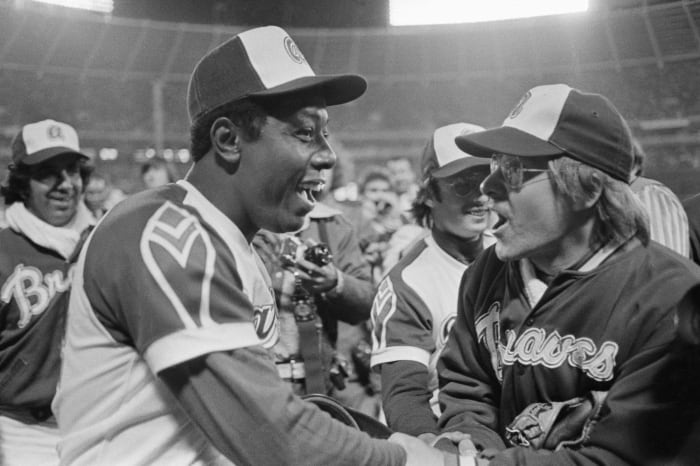
Bettmann/Getty Images
The career home run record of Babe Ruth had long stood as one of the most immortal and revered marks in all of sports. Then, on April 8, 1974, Hank Aaron passed the legendary Yankee as the most prolific home run hitter in the game’s history with the 715 th of his career. It capped a season of incredible stress for Aaron, who received a stream of racist death threats as he stood on the precipice of passing Ruth. Aaron went on to push the record to 755 before his retirement in 1976.
22 of 31
1975: Frank Robinson makes history off the field as well

Bettmann/Getty Images
Always an advocate for change and equality, Frank Robinson made his desire to manage no secret in the later stages of his career. In 1975, the Cleveland Indians gave him his wish, naming him player-manager of his new club. Robinson managed over 2,100 games in a managerial career spent with the Indians, Giants, Orioles, and Nationals. After his on-field career ended, he moved to the front office of Major League Baseball, where he served as vice president of on-field operations for 10 years. Later, he served as senior VP of major league operations and as honorary president of the American League. Robinson passed away earlier this month.
23 of 31
1977: The first black general manager

Dennis Wierzbicki/USA TODAY Sports
Bill Lucas first joined the Braves organization in 1965 after his six-year minor league career ended. By 1977, with the club amid a rebuilding stage under new owner Ted Turner, Lucas found himself in the crosshairs of history. In September 1976, he was promoted from director of the Braves’ farm system to the big club’s general manager, making him the first African-American to hold the title. Just under 30 years later, Kenny Williams of the Chicago White Sox became the first black GM to win a World Series.
24 of 31
1986: The Bonds legacy takes off
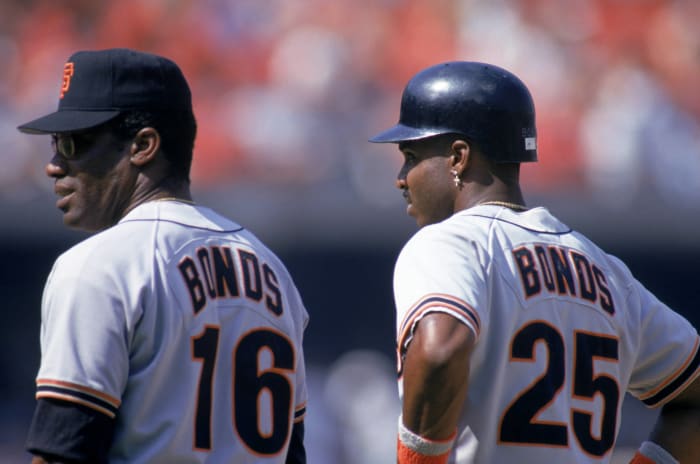
Bernstein Associates/Getty Images
Since Barry Bonds made his debut in 1986, no father and son duo has accomplished more than the Bonds, who combined for a whopping career 220.1 win shares in their respective careers. While seven-time MVP Barry did much of the heavy lifting, Bobby was no slouch himself, hitting 332 homers and stealing 461 bases. Combined, the Bonds hit 1,094 homers and made 17 All-Star teams.
25 of 31
1992: Cito Gaston carries the Blue Jays to the top, twice

Focus On Sport/Getty Images
In 1992, Cito Gaston became the first African-American manager to win a World Series title when he led the Toronto Blue Jays to the franchise’s first championship. A year later he doubled up on the feat by winning a second consecutive championship. Gaston won 894 games over two stints with the Blue Jays.
26 of 31
1991: Rickey runs into the record book

Bettmann/Getty Images
Never short for words or time spent on the base paths, Rickey Henderson ran his way into immortality in 1991. With a swipe of third base, he broke Lou Brock’s MLB record for stolen bases in a career with his 939 th. When it was all said and done, he finished his career with 1,406 steals — over 50 percent more than Brock’s previous record.
27 of 31
1994: Tony Gwynn flirts with .400

Rich Pilling/Getty Images
The loss of the 1994 season to a labor lockout (and eventual strike) stings for several reasons, as it was on course to potentially produce many historic outcomes. Among those sat Tony Gwynn’s pursuit of .400, a mark that had not been bested since Ted Williams’ .406 season in 1941. When the season was called off on Aug. 11, it ended his bid to meet the historic hit rate. However, Gwynn’s .394 mark in ’94 remains the highest average by an African-American batter ever, with the next closest season being another of Gwynn’s from 1997 when he hit .372.
28 of 31
2007: Robinson reaches immortality yet again

Jayne Kamin-Oncea-USA TODAY Sports
On April 15, 2004, 57 years to the day Jackie Robinson made his debut with the Brooklyn Dodgers, Major League Baseball officially observed the date in his honor. It has continued to mark not only the accomplishments of Robinson but also the legacy that followed in his wake. Although his No. 42 was officially retired by the game in 1997 to mark the 50th anniversary of his debut, Robinson’s number is reactivated every April 15 and worn across the backs of every player in the game.
29 of 31
2012: MLB’s first black owner

Kirby Lee-USA TODAY Sports
When the Los Angeles Dodgers went up for sale, a notable L.A. legend joined the Guggenheim group and Stan Kasten in vying to acquire the club: Magic Johnson. In March 2012, history surrounded the Dodgers yet again when the group’s record $2 billion winning bid made Johnson the first black owner in MLB history.
30 of 31
2016: Griffey resets the standard for Cooperstown
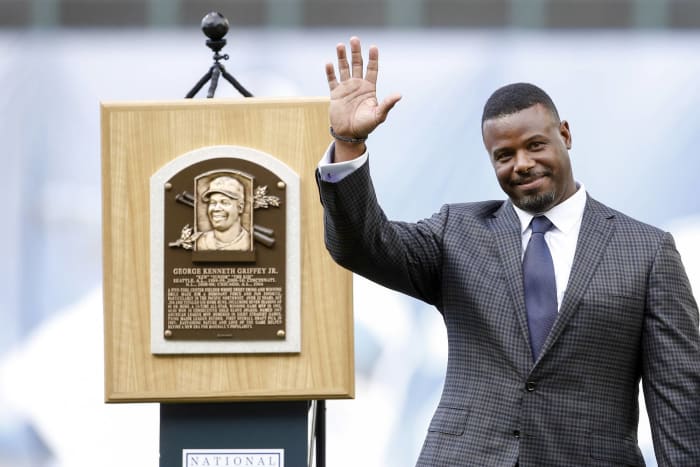
Jennifer Buchanan-USA TODAY Sports
Few players in history have been as beloved as Ken Griffey Jr. was throughout his career. He became a crossover star in the 1990s, hitting 630 home runs by the time he hung up his cleats in 2010. When his day came to be elected to Cooperstown, Junior was selected via historic acclaim. Griffey appeared on 99.3 percent of ballots, which was the highest percentage in Hall of Fame history until this year when Mariano Rivera received 100 percent of the votes.
31 of 31
2020: Overdue Recognition for Negro Leagues

The Rucker Archive/Icon Sportswire
In an effort to rectify the injustices of segregation, in 2020 the MLB made the proclamation that the Negro Leagues between 1920 to 1948 would be designated as “major league status”. Because of this, the Negro League statistics and records would be given parallel designation in the MLB history books and change how history is noted in the time range. The move will bring some of the greatest players of all-time that –missed the opportunity to compete in the MLB— such as Josh Gibson, Oscar Charleston, and Buck Leonard, into the MLB record books in significant fashion. It will also increase the total career numbers of legends such as Satchel Paige, Willie Mays, and Hank Aaron, who competed in both leagues.
Matt Whitener is St. Louis-based writer, radio host and 12-6 curveball enthusiast. He has been covering Major League Baseball since 2010, and dabbles in WWE, NBA and other odd jobs as well. Follow Matt on Twitter at @CheapSeatFan.
